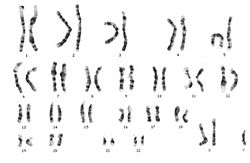X chromosome
Chromosome X' is one of a pair of human sex chromosomes. As a medium-sized submetacentric chromosome, it corresponds in size and shape to group C. In the latest assembly of the human genome, 2327 geness are annotated on the X chromosome [1]. Normally, each person receives one X chromosome from their mother. The second heterochromosome – either the X chromosome or the Y chromosome is then received from the father. In individuals with more than one X chromosome in their karyotype (that is, females and those with numerical aberrations of the X chromosome), these additional copies are inactivated in a process known as X inactivation.
Genes and Heredity
The inheritance of genes located on the X chromosome has its own characteristics, as a woman has two X chromosomes (lyonization is used here) and a man has only one (a man is a hemizygote) . We refer to this type of inheritance as gonosomal recessive or gonosomal dominant.
Pseudoautosomal regions
Certain genes are located in the so-called ``pseudoautosomal sections of the X chromosome. These are two sections - ``PAR 1 (the larger section) at the end of the short arm of the X chromosome and ``PAR 2 ' (smaller section) at the end of the long arm of the X chromosome. These genes have their homologous copies in the same order on the Y chromosome. These regions allow the X and Y chromosomes to form a "homologous" pair during meiosis; crossing-over can occur between genes in these regions. An example is the gene SHOX (Short Stature Homeobox; Xp22.32; OMIM: *312865) and its homologue the gene SHOXY ' (Yp11.2; OMIM: *400020).
Selected genes
- STS (Steroid sulfatase; Xp22.32; OMIM: *300747) - Encodes for steroid sulfatase; defect or deletion of this gene causes X-linked ichthyosis'.
- KAL1 (Kallman syndrome 1; Xp22.3; OMIM: +308700) - Encodes the protein anosmin-1; the mutation causes Kallman syndrome (central hypogonadism associated with anosmia).
- PIGA (Phosphatidylinositol glycan A; Xp22.1; OMIM: +311770) - Acquired mutation of this gene (at the hematopoietic stem cell level) causes Paroxysmal nocturnal hemoglobinuria.
- DMD (Dystrophin; Xp21.2; OMIM: *300377) - The gene encodes the muscle protein dystrophin; mutation of this gene causes muscular dystrophy of the Becker or Duchenne type.
- WAS' (Wiskott-Aldrich syndrome; Xp11.33-p11.22; OMIM: *300392 ) - A mutation in this gene causes a 'Wiskott-Aldrich syndrome (congenital immunodeficiency, thrombocytopenia, eczema).
- BTK (Bruton agammaglobulinemia tyrosine kinase; Xq21.3-q22; OMIM: *300300) - Mutations in this gene cause [ [Bruton's agammaglobulinemia|Bruton's agammaglobulinemia]] (congenital immunodeficiency).
- COL4A5 (Collagen, type IV, alpha-5; Xq22.3; OMIM: *303630) - Encodes the alpha chain [[collagen] ]in type IV, which is involved in the construction of basement membranes; mutation causes Alport syndrome (nephropathy associated with deafness).
- F9 (Factor IX; Xq27.1-q27.2; OMIM: *300746) - This gene encodes coagulation factor IX ; its mutation causes Hemophilia B.
- FMR1 (Fragile X mental retardation protein; Xq27.3; OMIM: *309550) - Mutations in this gene cause Fragile X Chromosome Syndrome.
- F8 (Factor VIII; Xq28; OMIM: +306700) - The gene encodes coagulation factor VIII ; its mutation causes Hemophilia A.
- MECP2 (Methyl-CpG-binding protein 2; Xq28; OMIM: *300005) - Mutations in this gene cause Rett syndrome (autism, stereotypical hand movements, affected almost exclusively by girls).
Chromosomal Abnormalities
Turner Syndrome
It is most often caused by monosomy of the X chromosome (karyotype 45,X'), or by various loss structural aberrations (for example, deletion on the second X chromosome, etc.). Numerical and structural changes can also occur in a mosaic. Classic manifestations are: short stature, ovarian dysgenesis with all the consequences, typical skin fold (pterygium colli). Intellect is not significantly impaired. Treatment with growth hormone and hormone replacement therapy is possible.
Klinefelter syndrome
It is caused by the presence of an extra X chromosome in a man. It is most often caused by the karyotype 47,XXY', variants with more X chromosomes (48,XXXY or 49,XXXXY) are also possible, which have a more pronounced manifestation. There are also mosaic forms. The main symptoms are: infertility' (aspermia), hypogonadism, average to tall height, long limbs, sparse hair, gynecomastia.
Syndrome 47,XXX
Chromosome X trisomy, also called Triple X syndrome' (and formerly "Superfemale syndrome"). As the name already suggests – it is caused by the karyotype 47,XXX, it can also occur in mosaic. Karyotype 48,XXXX or 49,XXXXX can also occur very rarely, these cases have a different and more serious manifestation. The 47,XXX syndrome itself does not have a distinct clinical picture, some women are examined for "infertility". There may be minor psychosocial problems, such as learning problems.
Links
Related Articles
- Chromosome
- Gonosomes
- Y chromosome
- Human Karyotype
- Chromosomal aberrations
- Sex-linked inheritance
- X-linked inheritance
References
- ↑ {{#switch: web |book = Incomplete publication citation. National Center for Biotechnology Information. 2022. Also available from <https://www.ncbi.nlm.nih.gov/genome/?term=Human>. |collection = Incomplete citation of contribution in proceedings. National Center for Biotechnology Information. 2022. Also available from <https://www.ncbi.nlm.nih.gov/genome/?term=Human>. {{ #if: |978-80-7262-438-6} } |article = Incomplete article citation. National Center for Biotechnology Information. Homo sapiens Genome: Build 38 patch release 14 (GRCh38.p14). 2022, year 2022, also available from <https://www.ncbi.nlm.nih.gov/genome/?term=Human>. |web = National Center for Biotechnology Information. Homo sapiens Genome: Build 38 patch release 14 (GRCh38.p14) [online]. ©2022. [cit. 7/11/2022]. <https://www.ncbi.nlm.nih.gov/genome/?term=Human>. |cd = National Center for Biotechnology Information. Homo sapiens Genome: Build 38 patch release 14 (GRCh38.p14) [CD/DVD]. ©2022. [cit. 7/11/2022]. |db = Incomplete database citation. Homo sapiens Genome: Build 38 patch release 14 (GRCh38.p14) [database]. ©2022. [cit. 7/11/2022]. <https://www.ncbi.nlm.nih.gov/genome/?term=Human>. |corporate_literature = Incomplete citation of company literature. National Center for Biotechnology Information. 2022. Also available from <https://www.ncbi.nlm.nih.gov/genome/?term=Human>. legislative_document = Incomplete citation of legislative document. 2022. Also available from URL <https://www.ncbi.nlm.nih.gov/genome/?term=Human>.







